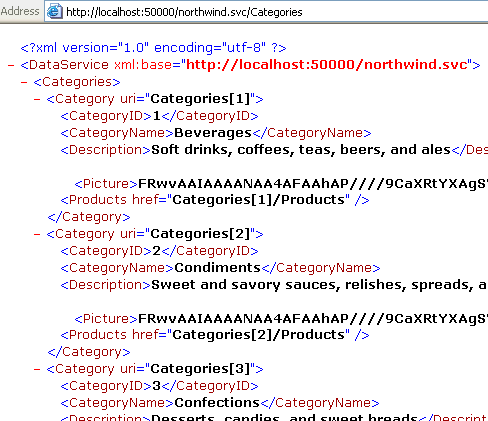I’ll be doing a session on Astoria at REMIX Boston 07 (10/8-10/9) and at the New England Code Camp (9/29-9/30).
What is Astoria?
Astoria exposes data as web services through an Entity Framework Data Model. Once exposed, you can use URI based syntax to query data through the conceptual layer of the entity data model. You can control what is and isn’t exposed and you can also do inserts, updates and deletes. The results can be output in a number of formats including JSON and ATOM.
It’s simplest to understand this by looking at some queries in a web browser. The Astoria CTP add-in for Visual Studio 2008 Beta 2 has a template for creating a Web Data Service that looks like a WCF service. It only needs one class to expose the whole kit n’ caboodle and that class inherits from WebDataService, a generic class. You merely need to tell that class that the type it is dealing with is the Entities class exposed by an Entity Data Model that you have created. The class doesn’t even have any code in it.
public class northwind : WebDataService<NorthwindModel.NorthwindEntities>
{
}
Then you can just make calls to that service and start playing with the query syntax.
The base service exposes the list of entities in the model (http://mysite/myservice.svc). The payload is just a raw XML representation of the data. There will be payloads for different formats, such as JSON, ATOM and more. See this Astoria team blog post for more info.

Then you can start drilling in. Here for example, I have asked for the Categories entities. It will return all entities with their details.

Now you can start seeing the URIs that are displayed to show you how to drill further into data. When looking at it in the browser, you might want to click on those URIs, but remember, in a real app this is not how you will be working with the results of the service call. 🙂 Note that you can see how to get to the related Products data although it is not pulled in automatically. That’s no different than how Entity Framework works by default – deferred loading of related data.
So let’s try the Category uri for categoryID 2.

And then get the products for that category.

So you can see now the basic concept of what Astoria is doing. I am not forced to write a billion operations in my web service to expose my data every which way. I don’t have to deal with building xmldocuments to return data that can be consumed by anyone, not just .NET clients that can deal with serialized datasets. With proper security in place and the possibility of customizing what is and isn’t exposed (and how), consumers of my data can now have easy access to do all kinds of reporting, mash-ups and more. The fact that any consumer will know what to do with any data that is exposed via an astoria web data service is huge.
You can learn more about Astoria by following the Astoria Team blog.
![]() Sign up for my newsletter so you don't miss my conference & Pluralsight course announcements!
Sign up for my newsletter so you don't miss my conference & Pluralsight course announcements! ![]()